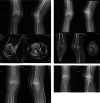Chondroblastoma in the Children Treated with Intralesional Curettage and Bone Grafting: Outcomes and Risk Factors for Local Recurrence
- PMID: 34599644
- PMCID: PMC8528993
- DOI: 10.1111/os.13153
Chondroblastoma in the Children Treated with Intralesional Curettage and Bone Grafting: Outcomes and Risk Factors for Local Recurrence
Abstract
Objective: To review the outcomes of surgical management in the pediatric patients with extremity chondroblastoma. Especially the risk factors of recurrence and growth disorder. And discuss a potential method to decrease the rate of growth disorder by preventing the premature physeal closure.
Methods: Fifteen girls and twenty-seven boys aged from two to 14 years (mean, 11 years) with histologically proven chondroblastoma, who presented from January 2011 to June 2018 at our Hospital, were retrospectively reviewed. Clinical data, radiographic images, histological findings, treatment, functional outcomes, and local recurrence rate were analyzed. Surgical treatment included complete curettage of the tumor and the walls of the lesion followed by bone grafting, No adjuvant methods were used. Recurrence was defined as a return of symptoms and an expansion radiolucency at the operated site. It was confirmed by the histopathological analysis. When recurrence was diagnosed, the medical data were analyzed to detect the effect of different factors on local recurrence. Functional outcome was measured according to Sailhan's functional criteria, designed to provide a standardized method of assessing pediatric chondroblastoma patient postoperatively.
Results: The proximal part of the femur was the most frequently involved site. All the patients had at least 24 months of follow-up; mean duration was 30 months (range, 24-60 months). The local recurrence rate was 9.5%. Three resolved after repeat surgeries without further recurrence, one had a second recurrence and received another more aggressive curettage. Local recurrence of chondroblastoma was associated with age (P < 0.05), while not associated with sex, tumor location, the radiological character of the lesion or the grafting method (P > 0.05). No pulmonary metastasis was noted at latest follow-up. Five patients suffered from premature closure of physis due to physis injury. Thirty-one patients (73.8%) had a good outcome, and all returned to normal unrestricted activities. Six patients (14.3%) had a fair outcome due to occasional pain, asymmetric range of motion, or radiographic joint changes without arthritis. And five patients (11.9%) had a poor outcome because of chronic pain, loss of joint motion impairing normal life activities, or a limb-length discrepancy and limp.
Conclusions: Aggressive curettage and bone grafting resulted in local control and good outcomes in most pediatric patients. Being less than 12 years of age was the risk factor for recurrence. For those growing patients, premature physeal closure was observed after the curettage, interpositional technique with PMMA would be a good choice for prevention.
Keywords: Bone grafting; Children; Chondroblastoma; Curettage; Recurrence.
© 2021 The Authors. Orthopaedic Surgery published by Chinese Orthopaedic Association and John Wiley & Sons Australia, Ltd.
Figures




References
-
- Kolodny A. Bone sarcoma: the primary malignant tumors of bone and the giant cell tumor. Surg Gynecol Obstet, 1927, 44: 1–214.
-
- Codman EA. The classic:epiphyseal chondromatous giant cell tumors of the upper end of the humerus. Surg Gynecol Obstet, 1931, 52: 543–548. - PubMed
-
- Suneja R, Grimer RJ, Belthur M, et al. Chondroblastoma of bone: long‐term results and functional outcome after intralesional curettage. J Bone Joint Surg Br, 2005, 87: 974–978. - PubMed
-
- Lin PP, Thenappan A, Deavers MT, Lewis VO, Yasko AW. Treatment and prognosis of chondroblastoma. Clin Orthop Relat Res, 2005, 438: 103–109. - PubMed
MeSH terms
LinkOut - more resources
Full Text Sources
Medical

